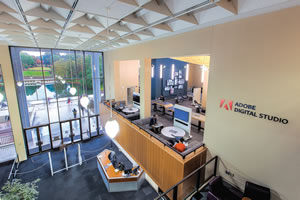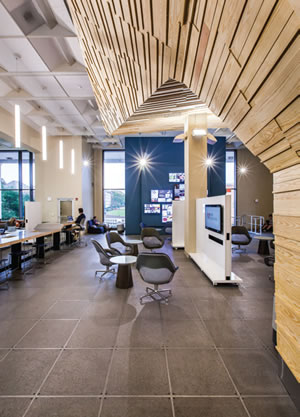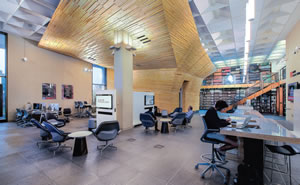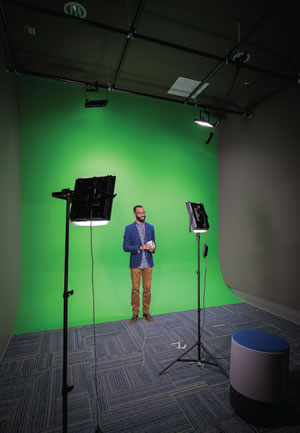A Groundbreaking Collaboration
- By David R. Moore II
- 10/01/16

PHOTOS © 2016 DERRICK SIMPSON, AIA / MCMILLAN PAZDAN SMITH ARCHITECTURE
Universities across the country are challenged to prepare students for careers in the “new economy,” and digital literacy is vital to their success. Faculty seek to engage students in active collaboration,
promote research and incorporate technology through their curriculum. Equipping students
with skills to effectively communicate across a multitude of digital platforms is an
essential 21st-century skill.
The Problem
In 2013, Clemson University ranked 21st in the nation among public universities, driven
in large part by their commitment to undergraduate research and an innovative curriculum
known as “Creative Inquiry.” Jim Bottum, Clemson’s chief technology officer, had been helping
to support this commitment by empowering the university’s departments to embrace the digital revolution and build technology
into their curricula. Early successes from
these efforts include Clemson’s Social Media
Listening Center, Data Visualization Center
and many others.
As momentum increased towards developing
a more digitally literate campus,
Bottum began to hear from faculty and
students with suggestions to improve this
effort — primarily requests for new software.
As he dug deeper into these repeated
requests, he was surprised to learn how
robust Adobe’s software packages had
become. “My initial reaction was, ‘Whoa, I
didn’t know they had all this,’ and that led
immediately into trying to determine the
demand across campus,” says Bottum.

PHOTOS © 2016 DERRICK SIMPSON, AIA / MCMILLAN PAZDAN SMITH ARCHITECTURE
He quickly discovered the university did
not have a site license for Adobe’s software,
and everyone had to buy the programs on
his or her own. There was a disparity in the
tools used throughout campus, as some
could afford the programs and others could
not. According to Bottum, “Students were
telling us that they were having to choose
between books and software; or, they could
do homework on one operating system but
not another. We realized we had a broken
business model, not just in the ‘business
sense’ but also in the functional sense. We
weren’t serving our users or the university
as well as we could.”
Motivated to fix the broken model and
empower students and faculty to maximize
the technologies available to them, Bottum
reached out to Jon Hammond, Adobe’s
North American vice president of Field
Operations for Education, and proposed a
new model that he believed would be a win/win for everyone.
The Proposal
Intrigued with Jim’s idea of advancing
digital literacy supported by the Adobe suite
of software, Jon Hammond agreed to explore
the idea further. After a few short months
of serious conversations, in February 2014,
a multidisciplinary team from Clemson
University submitted a formal proposal to
Adobe Systems, detailing a unique publicprivate
partnership that grew from Jim and
Jon’s initial conversations.
In less than 12 months from the initial
conversation, it was agreed that Adobe’s
Creative Cloud suite would be made available
to all 27,000 of the university’s students,
faculty members and staff, including
both traditional and online students. The
vision for this comprehensive, universitywide
licensing solution made Adobe’s
software ubiquitous across the full range
of projects, scholarly research, creative
design, publishing initiatives and professional
development at the university.

PHOTOS © 2016 DERRICK SIMPSON, AIA / MCMILLAN PAZDAN SMITH ARCHITECTURE
To ensure effective implementation
of this wide-reaching plan, Clemson also proposed a physical space, accessible to
everyone, in the R. M. Cooper Library,
which is located in the heart of Clemson’s
campus. This new collaborative studio
would support Creative Cloud users, facilitate
training and workshops, and showcase
the next generation of creativity.
Overwhelmed by the university-wide collaborative
and cooperative spirit displayed
by Clemson, Adobe responded positively to
the proposal, easily understanding the value
of a synergistic partnership and a pipeline of
workforce-ready graduates who would know
the Adobe software suite and be skilled at
using it to create digital content.
“Prior to Clemson’s proposal, the
inequity of software availability and access
to it by students and faculty was obvious,
and the potential availability of Adobe’s
workplace-ready tools to everyone would
be a game-changer,” says Kay Wall, former
dean of Clemson’s Libraries. “We felt that
if every student graduated fluent in the
Adobe suite, they would be more competitive
and relevant to the workplace.”
The plan was quickly finalized and
Adobe even agreed to fund the construction
of a new on-campus Adobe Digital
Studio in the library as part of their commitment
to Clemson. “When Adobe gave
us that gift for the studio, I think it was
the first time Adobe ever wrote a check to a
university,” says Bottum. “So many times,
people get a deal from a vendor, but where’s
the partnership? Where’s the skin in the
game on each side? They actually put cash
into this studio, and that’s a big deal.”
The Partnership
The Cooper Library is one of the most
heavily trafficked buildings on Clemson’s
campus and an ideal location for the Adobe
Digital Studio. Like most 21st-century
academic libraries, it is a neutral, nondepartmental
space and a hub for learning
activities that engage collaboration and
cross-disciplinary discovery. It is also where
Bottum and Wall first collaborated a year
earlier to create a high-end technology classroom
known as the Edgar Brown Digital
Resource Laboratory. This space was funded
through grants from Dell and the National
Science Foundation, and was space that laid
the groundwork for the Adobe Studio.
“Libraries are for creating and sharing
information, as much as for finding it,”
says Wall. “Our vision for the library as a
vehicle for collaboration made it a perfect
location for the Adobe Studio. It worked because
we were not territorial about ‘library
space.’ We viewed it as ‘university space,’
and sought what was best for the students.”
Clemson University engaged Good City
Architects and the higher education firm McMillan Pazdan Smith to convert 3,200
square feet of library space into a studio for
digital collaboration that encourages users
to experiment with both the Adobe software
and the space. The studio includes an Adobe
Help Desk, a video production studio with
horizon-less green screen, an audio production
studio and collaborative workstations.

PHOTOS © 2016 DERRICK SIMPSON, AIA / MCMILLAN PAZDAN SMITH ARCHITECTURE
IT’S EASY BEING GREEN. In today’s world, media of all
types surround us and communications have moved far
beyond textbooks and written reports. In light of this,
Clemson University sought to integrate industry-standard
creative desktop and mobile apps across its entire curriculum
and provide a new space for inspiration — and
collaborated with Adobe to make it happen. The results of
that partnership have been a resounding success.
As Clemson and Adobe’s partnership
matured, the creativity and excitement of
the studio’s design grew. The Adobe Digital
Studio combines two shapes — a controlled
environment for video production,
and the shell of the entire space, designed
for change. The resulting “smash up” is a
whirlwind-shaped vortex that rises to the
ceiling, nicknamed “the Tornado.” Constructed
of wood and located in the center
of one of the highest-tech spaces on campus,
the design provides contrast and a bit of
irony to the environment. In a space where
people connect and disconnect and coalesce
around ideas, then break away to work in
solitude, the “Tornado” becomes the iconic
organizing element for the studio.
“It’s illustrative of the fact that
everything about this studio, everything
surrounding the Tornado, is designed to
change and evolve and move over time,”
says Ron Geyer, managing principal at
Good City Architects.
A Winning Formula
The partnership took little time to
bear fruit. In fact, the Clemson University
Athletic Department (CUAD) took full advantage
of the Clemson-Adobe partnership.
As the partnership was coming together,
the CUAD’s sports communications team
was exploring how to better connect with
fans, supported by engaging students
in more strategic social media efforts.
Director of Communications Joe Galbraith
and Director of New Media Jonathan
Gantt were instrumental in finding ways
to enable students to use the Adobe tools
to share digital content and promote the
university’s powerful brand content.
“Every student on campus has Creative
Cloud for free — to have that at your fingertips
means you don’t have to go to an art
school to get amazing graphics. We used a
significant number of students armed with
direction and the right products to make
these things happen,” says Tim Match,
Clemson’s assistant athletic director. “During
our football team’s run to the National
Championship last year, we added over
21,000 followers on social media accounts
and received over 21 million impressions.”
Clemson University was voted the #1
Twitter account in college football by Sports
Illustrated and Athlon, and the #2 college
account by USA Today. Collectively, their
social media accounts received over 320
million impressions in 2015 alone. Many
have taken notice, and some unlikely organizations
have reached out to learn how
Clemson has been so successful in its social
media outreach. “When you’ve got Manchester
United, the MLB and other Power 5
Conference schools calling Jonathan Gantt
and saying ‘We want to do it the Clemson
Way,’ that’s a big pat on the back,” says
Match. “Technology is such a huge part of
what we do now thanks to Jim Bottum and
relationships like Adobe.”
A Pattern for Growth
The Clemson-Adobe partnership is the
model for many that Adobe is now building
with other higher education institutions. The
momentum from what started as Jim’s vision
for helping students has carried over to more
than 40 schools throughout the country.
“Clemson was absolutely a template for
this type of thing and a wonderful partner
to us as well,” says Hammond. “They really
were a catalyst in encouraging these types
of relationships.”
Since the initial partnership was
formed, Bottum and Hammond have
worked together on helping share Clemson’s
success story. “This is wonderful
for Clemson, it’s been transformational,”
says Bottum. “But if it just sits on Clemson’s
campus, it’s just going to be
wonderful for Clemson.” Together,
Bottum and Hammond helped pioneer
campus-oriented conferences around
collaborative possibilities, bringing
Adobe and other technology companies
together with college and university
presidents and CIOs.
“Really though, the big outcome is seeing
the growth in the students,” says Bottum.
“I get letters from faculty saying things like
‘this transformed my classroom’ and letters
from students saying they got the job they
wanted because of this partnership and
the skills they learned. It’s anecdotal, but if
there’s seven or eight who took the time to
write you, how many more actually did get
great jobs because of this as well?”
“This is not just about school, but about
empowering a generation of students to
have a socially conscious voice,” says Hammond.
“We’re empowering them to tell
their story and to have it told globally, and
that’s a great outcome.”
This article originally appeared in the issue of .